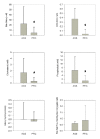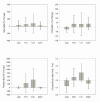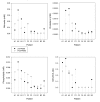Bile composition in Alagille Syndrome and PFIC patients having Partial External Biliary Diversion
- PMID: 18937870
- PMCID: PMC2585081
- DOI: 10.1186/1471-230X-8-47
Bile composition in Alagille Syndrome and PFIC patients having Partial External Biliary Diversion
Abstract
Background: Partial External Biliary Diversion (PEBD) is a surgical intervention to treat children with Progressive Familial Intrahepatic Cholestasis (PFIC) and Alagille syndrome (AGS). PEBD can reduce disease progression, and examining the alterations in biliary lipid composition may be a prognostic factor for outcome.
Methods: Biliary lipid composition and the clinical course of AGS and PFIC patients were examined before and after PEBD.
Results: Pre-PEBD bile from AGS patients had greater chenodeoxycholic/cholic acid (CDCA/CA), bile salt, cholesterol and phospholipid concentrations than PFIC patients. AGS patients, and PFIC patients with familial intrahepatic cholestasis 1 (FIC1) genotype, responded better to PEBD than PFIC patients with bile salt export protein (BSEP) genotype. After successful PEBD, AGS patients have higher biliary lipid concentrations than PFIC patients and PEBD also increases biliary phospholipid concentrations in FIC1 patients.
Conclusion: Both AGS and FIC1 patients can benefit from PEBD, and preserved biliary phospholipid concentrations may be associated with better outcomes post-PEBD.
Figures



References
-
- Carlton VE, Pawlikowska L, Bull LN. Molecular basis of intrahepatic cholestasis. Ann Med. 2004;36:606–617. - PubMed
-
- Whitington PF, Freese DK, Alonso EM, Schwarzenberg SJ, Sharp HL. Clinical and biochemical findings in progressive familial intrahepatic cholestasis. J Pediatr Gastroenterol Nutr. 1994;18:134–141. - PubMed
Publication types
MeSH terms
Substances
Grants and funding
LinkOut - more resources
Full Text Sources

